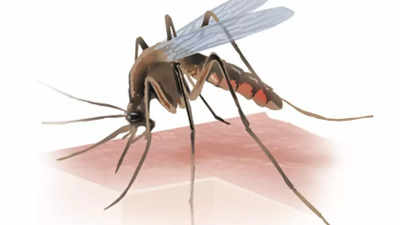- News
- City News
- nagpur News
- Gadchiroli sees 97% of about 2,000 malaria cases in Nagpur division
Trending
This story is from April 26, 2022
Gadchiroli sees 97% of about 2,000 malaria cases in Nagpur division
The Nagpur division comprising six districts has recorded nearly 2,000 malaria cases between January and April 21 this year. While Nagpur and Bhandara have reported only one case, Wardha has remained free of malaria this year so far. Gadchiroli has recorded nearly 1,900 cases, which is 97% of the division’s total cases in the last four months, and three deaths too.

Representative image
NAGPUR: The Nagpur division comprising six districts has recorded nearly 2,000 malaria cases between January and April 21 this year. While Nagpur and Bhandara have reported only one case, Wardha has remained free of malaria this year so far. Gadchiroli has recorded nearly 1,900 cases, which is 97% of the division’s total cases in the last four months, and three deaths too.

The figures from just first four months are close to 71% of what the division had recorded in entire 2019, the pre-Covid year.
Of the total cases in division this year so far, 1,445 samples tested positive for Plasmodium falciparum which increases the risk of brain malaria. The disease caused by this parasite is treatable.
The office of deputy director of health services, Nagpur circle, has initiated several campaigns to prevent the spread of the vector-borne disease on the occasion of World Malaria Day observed on Monday.
“The health department’s active intervention would ensure the malaria peak seen during monsoon period remains subdued,” said Dr Nimgade.
The theme for this year is ‘We will do something new to halt the transmission of malaria’. Innovative ways would be deployed to prevent the spread of malaria. “Surveillance in malaria-prone districts are being organized every quarterly. We have identified high risk primary health centres in Gadchiroli districts. Irrespective of symptoms, we are collecting blood samples of entire population under these PHCs. All positive cases are brought under treatment even if they don’t have any symptoms. This will break the transmission,” he said.
Every 10 days, multipurpose workers will also survey the population under different PHCs. “This year, we have projected a drop in overall cases in the division. This month fewer positive cases were detected after spike till March this year,” the official said.
In the last two years, the department had observed malaria growth rate jumped to twice in three districts – Gadchiroli, Chandrapur and Gondia.
“Due to Covid second wave, the routine surveys and management of containers and breeding spots was hampered. Our main activity is undertaken during monsoon but all our healthcare staff was engaged in Covid management in last two years. Hence, the disease prevalance increased as mosquito breeding prevention measures could not be taken on time,” he said.

The figures from just first four months are close to 71% of what the division had recorded in entire 2019, the pre-Covid year.
Of the total cases in division this year so far, 1,445 samples tested positive for Plasmodium falciparum which increases the risk of brain malaria. The disease caused by this parasite is treatable.
Cases have consistently been on a high in Gadchiroli, Chandrapur and Gondia from 2019 to 2022 till date. “These districts have large forested areas, rice belts and are adjacent to malaria-prone part of Chhattisgarh. Transborder infection and migration of population is leading to high prevalence of malaria in these districts,” said said Dr Shyam Nimgade, assistant director of health services (malaria).
The office of deputy director of health services, Nagpur circle, has initiated several campaigns to prevent the spread of the vector-borne disease on the occasion of World Malaria Day observed on Monday.
“The health department’s active intervention would ensure the malaria peak seen during monsoon period remains subdued,” said Dr Nimgade.
The theme for this year is ‘We will do something new to halt the transmission of malaria’. Innovative ways would be deployed to prevent the spread of malaria. “Surveillance in malaria-prone districts are being organized every quarterly. We have identified high risk primary health centres in Gadchiroli districts. Irrespective of symptoms, we are collecting blood samples of entire population under these PHCs. All positive cases are brought under treatment even if they don’t have any symptoms. This will break the transmission,” he said.
Every 10 days, multipurpose workers will also survey the population under different PHCs. “This year, we have projected a drop in overall cases in the division. This month fewer positive cases were detected after spike till March this year,” the official said.
In the last two years, the department had observed malaria growth rate jumped to twice in three districts – Gadchiroli, Chandrapur and Gondia.
“Due to Covid second wave, the routine surveys and management of containers and breeding spots was hampered. Our main activity is undertaken during monsoon but all our healthcare staff was engaged in Covid management in last two years. Hence, the disease prevalance increased as mosquito breeding prevention measures could not be taken on time,” he said.
End of Article
FOLLOW US ON SOCIAL MEDIA










